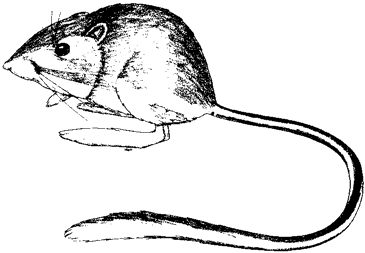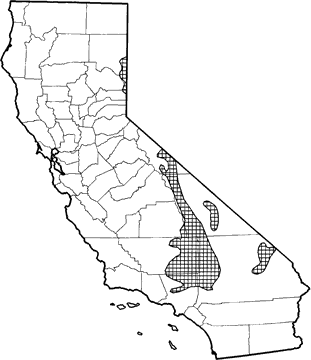
Panamint Kangaroo Rat
Distribution, Abundance, and Seasonality
In California, the Panamint kangaroo rat is found in suitable habitat in the vicinity of Beckworth Pass, Plumas Co., then south through the Owens Valley to Lake Isabella, Walker Pass, and Mojave in Kern Co., and Hesperia, in San Bernardino Co. Also found in Willow Creek in the Panamint Mts., and Junction Ranch in the Argus Mts. of Inyo Co., and in the Providence Mts. of San Bernardino Co. from Purdy, southwest to Granite Well. Preferred habitats of the Panamint kangaroo rat are pinyon-juniper, Joshua tree, and sagebrush (Harvey 1972, O'Farrell 1973,1974).

Range Map
Specific Habitat Requirements
Feeding: As with all heteromyids, D. panamintinus is a nocturnal granivore. Seeds of forbs, shrubs, and grasses are taken from sandy-gravelly soil between and beneath desert shrubs.
Cover: No data found.
Reproduction: No data found.
Water: Water is obtained metabolically from food and from moisture in food.
Pattern: Occurs on sandy-gravelly soils, usually with an overstory of big sagebrush, pinyon pine, juniper, or yucca. Comparable habitats that lack all of these plants are more likely habitats of D. microps. Within the sagebrush habitats, D. panamintinus is found at higher elevations with D. microps at lower elevations.
Species Life History
Activity Patterns: Yearlong nocturnal activity.
Seasonal Movements / Migration: None.
Home Range: Activity radius of 15-21 m (50-70 ft) reported by Bartholomew and Caswell (1951).
Territory: Assumed similar to home range. Highly aggressive. Seldom climb (Bartholomew and Caswell 1951).
Reproduction: Reproduction occurs from February into August. An average of 3 young born to each female (range 1-4); young weaned at 27-29 days (Eisenberg and Isaac 1963).
Niche: No additional information found.
Sources & References
California Department of Fish and Game, 1999.
California's Wildlife, Sacramento, CA.
Written by: P. Brylski, reviewed by: H. Shellhammer, edited by: R. Duke
Bartholomew, G. A., and H. H. Caswell. 1951. Locomotion in kangaroo rats and its adaptive significance. J. Mammal. 32:155-169. Eisenberg, J. F., and D. E. Isaac. 1963. The reproduction of heteromyid rodents in captivity. J. Mammal. 44:61-67. Hall, E. R. 1946. Mammals of Nevada. Univ. California Press, Berkeley. 710pp. Hall, E. R. 1981. The mammals of North America. Second ed. 2 Vols. John Wiley and Sons, New York. 1271pp. Harvey, D. E. 1972. Infrasubspecific variation in the kangaroo rat, Dipodomys panamintinus mohavensis (Rodentia: Heteromyidae), from the Mohave Desert of California. M.A. Thesis. Calif. State Univ., Long Beach. 59pp. O'Farrell, M. J. 1973. Seasonal activity patterns, population dynamics, and spatial relationships of rodents in a sagebrush community. Ph.D. Thesis, Univ. Nevada, Reno. 168pp. O'Farrell, M. J. 1974. Seasonal activity patterns of rodents in a sagebrush community. J. Mammal. 55:809-823.
California Animal Facts | California's Wildlife